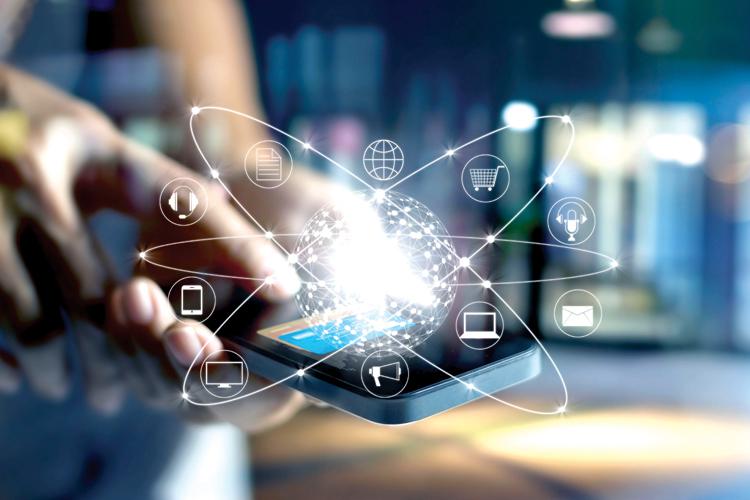
While current mobility patterns are based on menu-driven and GUI-based tools, ubiquitous computing holds the promise of understanding natural human interactions such as presence, movement, or speech
We are in the most interesting times today...the times of “Tsunami Transformation”. In such an evolutionary stage of transformation, it is sometimes very difficult to pin-point the stage of transformation that we are in.
If we take a look at the history of interaction, you will realize that every form of human interaction is unique to the actors involved; heterogeneity is what defines us as humans.
Just visualize how interactions have transformed over times.
Circa 1440 BC, Moses receives the 10 commandments on the two not-so-lightweight Blue Sapphire stone tablets called Tablets of Testimony. Fast forward to the early 19th century when the first typewriter was developed comprising 2500 parts, and enter developments in mid 50s of the erstwhile century when the foundations of avatar of the current IT were laid.
As technology has progressed, these tools have evolved into standalone devices that could support more forms of interaction—hence the emergence of the mobile smartphone, a small computer that allows us to stay connected and helps us interact with people and computers in a variety of ways.
The locus of innovation has moved to the world of the consumer, which had previously been, firmly, in the realm of business technology. The opportunity to use consumer devices and other on-demand services for business purposes has given rise to a concept called consumerization of IT.
Welcome to the world of Mobility!
Here you are served everything from snack-on-the-go to formally closing a multi-billion dollar deal; collaborated invisibly and virtually.
The customers’ expectations of total mobility, ever-faster connectivity, personalized services and perfect instantaneous delivery seem to be growing as quickly as their data usage. At the same time, the pace of change is unprecedented – cloud, M2M communications, rapidly evolving world of devices and apps, etc.
Expectations and technology are feeding into each other, creating the need for faster innovation and time to market, improved network infrastructure, and so on.
Impact
For most part, hardware peripherals will probably not see a substantial impact from mobility. The area most impacted by mobility is the network and the impact is both:
- Constructive —creation of newer network infrastructures—and
- Destructive —obsolescence of older technologies.
Newer and faster network standards are excellent from point of view of very high throughput using Multiple Input Multiple Output (MIMO) systems, in the range of over 100 Mbps.
When it comes to IT facilities, Mobility will change the way employees operate. Workplaces will actually shrink to the size of a small mobile device while coverage of work itself, and go beyond the confines of physical establishments.
Below are some examples of umpteen possibilities in the future:
Bluetooth-enabled mobile devices carried by fire marshals in factory premises, keep updating their current position on the floor supervisor’s dashboard through wall-mounted sensors, resulting in faster response time.
Richness in communication channels will help product development and marketing, where enterprises can exploit augmented reality applications for product demonstrations, and to address consumer pain points faster and more effectively.
Applications already allow smartphones to scan barcodes. Coupled with this, RFID tags connected to inventory items can be read using Near Field Communication (NFC) enabled mobile devices and supply chain managers will get real-time information on materials movement in ERPs, crucial in a Just-In-Time (JIT) environment, reducing inventory costs to a bare minimum.
Same RFID tags will also help with quality control.
Surveillance of plant facilities or premises under large uneven topography are being aided by enterprise mobility without the need for expensive wiring.
Sensors on machines in a factory allow technicians to know when maintenance is needed.
Mobility will develop wireless M2M and human-machine-interfaces, allowing designated personnel to supervise and control shop-floor activities from anywhere, demonstrating ubiquitous control.
With all this happening in the mobility space at a lightening pace, this mobility trend, which still is in infancy, is auto-terminating into something called Ubiquitous Computing, which is both intelligent and pervasive.
Below are key differences between mobility and ubiquitous computing:
Ubiquitous computing lets the environment connect to you in many unobtrusive ways whereas Mobility took computers from desktop and put them in your pocket.
Ubiquitous computing sends information seamlessly into your environment, where numerous tiny devices monitor you, connect with you, and even think for you.
While current mobility patterns are based on menu-driven and GUI-based tools, ubiquitous computing holds the promise of understanding natural human interactions such as presence, movement, or speech.
A lot of ubiquitous computing is already in use.
Today when I enter my office, the lights come on automatically and when I leave, they go off.
In the near future, several actions may be triggered as I set out to work. For instance, smart cars will suggest an optimal route by assessing traffic along a smart city network. My virtual assistant may send an alert and the office temperature will adjust to my preference. My desk will show high priority tasks and the scheduler will prepare visitor passes for guests. The cafeteria will receive a request for preferred beverages. We may be able to automatically connect to video conference on the basis of confirmed invitations. The translation services based on the geography of our customers will be activated.
In short, when many smart devices connect, an intelligent environment will get created – envisioning a world of ubiquitous computing.
So long, Mobility!

 In
In
Comments
Cialis Viagra Marche Pas
Cialis Viagra Marche Pas https://buycialisuss.com/ - Cialis Zithromax For Babies <a href=https://buycialisuss.com/#>buy cialis online reviews</a> order levitra online
Cialis Viagra Marche Pas
Cialis Viagra Marche Pas https://buycialisuss.com/ - Cialis Zithromax For Babies <a href=https://buycialisuss.com/#>buy cialis online reviews</a> order levitra online
Cialis Viagra Marche Pas
Cialis Viagra Marche Pas https://buycialisuss.com/ - Cialis Zithromax For Babies <a href=https://buycialisuss.com/#>buy cialis online reviews</a> order levitra online
Add new comment